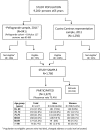Frailty prevalence and slow walking speed in persons age 65 and older: implications for primary care
- PMID: 23782891
- PMCID: PMC3691628
- DOI: 10.1186/1471-2296-14-86
Frailty prevalence and slow walking speed in persons age 65 and older: implications for primary care
Abstract
Background: Frailty in the elderly increases their vulnerability and leads to a greater risk of adverse events. According to various studies, the prevalence of the frailty syndrome in persons age 65 and over ranges between 3% and 37%, depending on age and sex. Walking speed in itself is considered a simple indicator of health status and of survival in older persons. Detecting frailty in primary care consultations can help improve care of the elderly, and walking speed may be an indicator that could facilitate the early diagnosis of frailty in primary care. The objective of this work was to estimate frailty-syndrome prevalence and walking speed in an urban population aged 65 years and over, and to analyze the relationship between the two indicators from the perspective of early diagnosis of frailty in the primary care setting.
Methods: Population cohort of persons age 65 and over from two urban neighborhoods in northern Madrid (Spain). Cross-sectional analysis. Bivariate and multivariate analysis with binary logistic regression to study the variables associated with frailty. Different cut-off points between 0.4 and 1.4 m/s were used to study walking speed in this population. The relationship between frailty and walking speed was analyzed using likelihood ratios.
Results: The study sample comprised 1,327 individuals age 65 and older with mean age 75.41 ± 7.41 years; 53.4% were women. Estimated frailty in the study population was 10.5% [95% CI: 8.9-12.3]. Frailty increased with age (OR = 1.14; 95% CI: 1.10-1.19) and was associated with poor self-rated health (OR = 2.52; 95% CI: 1.43-4.44), number of drugs prescribed (OR = 1.17; 95% CI: 1.08-1.26) and disability (OR = 6.58; 95% CI: 3.92-11.05). Walking speed less than 0.8 m/s was found in 42.6% of cases and in 56.4% of persons age 75 and over. Walking speed greater than 0.9 m/s ruled out frailty in the study sample. Persons age 75 and older with walking speed <0.8 m/s are at particularly high risk of frailty (32.1%).
Conclusions: Frailty-syndrome prevalence is high in persons aged 75 and over. Detection of walking speed <0.8 m/s is a simple approach to the diagnosis of frailty in the primary care setting.
Figures
References
-
- Fried LP, Tangen CM, Walston J, Newman AB, Hirsch C, Gottdiener J. et al.Frailty in older adults: evidence for a phenotype. J Gerontol A Biol Sci Med Sci. 2001;56:46–56. - PubMed
Publication types
MeSH terms
Substances
LinkOut - more resources
Full Text Sources
Other Literature Sources



